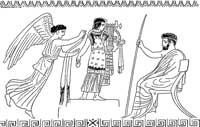Part 1: Instruments
Music "the art of combining tones in a manner to please the ear" [Webster].
..and there the Greeks can be our masters and teachers, as they have been our masters and our teachers in so many other things. They can show us the way back to a consciousness of that universality that underlies all human achievements. They can make us once more realize that nothing in this world exists quite in and by and for itself, but that everything pertaining to the human spirit is correlated and interrelated with everything else. And by so doing they can once more give us a feeling for something that is in truth the beginning and end of all wisdom.
Hendrik van Loon The Arts
Griechische Musik - Instrumente

Contest of Apollo and Marsyas, 350-320 BC from Mantineia. Part of the Base of a Sculpture, National Museum of Athens, Greece. Marsyas took the flute that was thrown away by Athena.
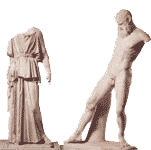
A copy of a work of Myron, Marsyas desirous of picking up the aulos thrown away by Athena.
Pythagoras is the Father of Music Theory. The link between numbers and music was observed by Pythagoras by analyzing the vibrations of strings of various lengths. According to legend he discovered the mathematical rationale of musical consonance from the weights of hammers used by smiths. He found that the interval of an octave is rooted in the ratio 2:1, that of the fifth in 3:2, that of the fourth in 4:3, and that of the whole tone in 9:8. The Pythagoreans applied these ratios to lengths of a string on an instrument called a canon, or monochord ( a board with two bridges between which a string is stretched and a third bridge that divides the string in two parts), and thereby were able to determine mathematically the intonation of an entire musical system.

Chorgestühl (1469 – 1474) im Ulmer Münster. A medieval sculpture of Pythagoras as a musician, a work of Jörg Syrlin. wood sculpture, Cathedral of Ulm, Choir stalls, Germany.
"There is surely no more impressive site in the world than the Temple of Apollo at Delphi on Mount Parnassus; of all the glorious holy places, this site of the Oracle of Delphi established the link between music and mystery.... The word music itself comes for the Greek word musiki, meaning all the arts of the nine Muses. Apollo, son of Zeus, was the leader of the Muses, as master athlete and warrior as well as master musician. Mount Parnassus came to be thought of as the home of music." Yehudi Menuhin, The Music of Man
Ancient Greek Musical Instruments
Μουσικά όργανα της αρχαίας Ελλάδας
Lyre (λύρα)

Chalkidiki Coin, Apollo and a Lyre with seven strings, inscriptions "Chalkideon" |
Family of Instruments. The Lyre, with 3 strings, according to mythology was invented by Hermes and was given to Apollo (who some say added another 4 strings). Most common probably was the lyre with 7 strings but there are versions with more strings for example 9 strings (Theophrastus of Piera), 10 strings (Histaeus of Colophon) or 12 strings (Melanippides)
The elements of a lyre:
The soundbox (echeion), the 2 arms peichis (πήχεις ) or kerata. The crossbar (zygon) joining the 2 arms, the strings (chordai or neurai), gut or linen, attached to the chordotonion or chordotonos, situated in the lower part of the soundbox. The strings passed over a bridge (magas) and stretched to reach the zygon, where they were fixed by mobile leather or cotton rings or pegs called kollaboi and kollopes.
Orpheus obtained the Lyre from Apollo when he was a child and lessons how to play it. Historical it is an instrument that was known at least around 3000 BC in Ur. The lyre was known in Crete at least before 1400 as the Agia Triada Sarcophagus fresco shows a musician who plucks at a seven-stringed lyre with a plectrum (and also an Aulos player is shown). According to a story Orpheus Lyre was thrown in a river and after a journey reached Apollo's temple in Lesbos. Apollo asked Zeus the Lyre to become a constellation, the Lyra constellation, with the known star Vega that once was the polar star. (Strange but it is called by the Britons also King Athur's Harp Star).
Amphion is said to have built Thebes by the music of his lyre.
"O, had I lived when song was great
In days of old Amphion," Alfred Lord Tennyson

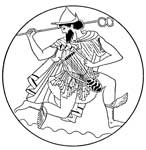

Coin with seven string Chelys Lyra, Calymna (Kalymnos)
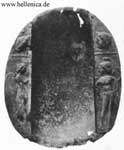
Chelys Lyra (χέλυς λύρα) (using a tortoise shell covered by leather). Instrument found at weddings (epithalamia), symposia, and komoi, (activities with men dancing). It was played by women: hetairai or courtesans who entertained at the symposia or respectable women who played at weddings or for their own entertainment. We have also a story how this instrument was discovered by Hermes. At the age of one day (!!!), he climbed out of his cradle and he found the shield of a turtle. The place was in Corinthia in the today municipality Evrostina around the mountain Chelydoris. He stretched the skin of a cow around it, fixed two horns through the holes were once the paws of the animal stood and he tied strings at the horizontal connection between the arms. The cow was taken from the cattle of his brother Apollo who was angry until Hermes offered him the lyre. Another version from A catechism of familar things: It is supposed to have originated from the discovery of a dead tortoise, the flesh of which had dried and wasted, so that nothing was left within the shell but sinews and cartilages: these, tightened and contracted, on account of their dryness, were rendered sonorous. Some one, Mercury or Apollo, they affirm, in walking along, happening to strike his foot against the tortoise, was greatly pleased with the sound it produced. From Diane Touliatos-Miliotis: The other parts of the chelys-lyra included a "donax," which was a cane or reed that possibly functioned as a bridge or brace for the arms. The "pecheis (πήχεις )" were the arms of the lyra that entered the soundbox from the front. The "zugon" or crossbar was notched across the upper ends of the arms to which the seven strings of sheepgut were attached. The chelys-lyra had the same kollopes and plektron as the kithara, but the plektron cord was attached to the base of the outer arms more often than to the base of the soundbox. See also Creese, David E. (David Evan). The origin of the Greek tortoise-shell lyre, PhD Thesis (PDF 6 MB)
Hermes making the lyre. Bronze relief in the British Museum (Fourth century BC)


Phorminx (φόρμιγξ) (Similar to the kithara but the arms are straighter and more parallel, and were often elaborately carved, 2) the wooden soundbox of the phorminx has a softer, rounder curve to it, and 3), the soundbox almost always displays unique circle or "eye" designs on its face.) Probably played mainly by women and used as a domestic instrument. After the middle of the 4th century BC not in use. A Phorminx version named by Max Wegener in 1949 the cradle-Kithara (Wiegenkithara) From Diane Touliatos-Miliotis: Homer also refers to the phorminx as bright sounding (ligus) and ornate (daidaleos) in decoration. Homer continues to give us a description of the construction of the instrument by indicating that the instrument's strings were made of sheepgut and that kollopes were used as tuning devices. The kollops over which the string was pulled was a roll of rough leather. It was the roughness which held the string in place at the crossbar. From a Byzantine writer by the name of Eustathius, we know that the kollops was a tuning device made from the hide of the necks of oxen or sheep. Because the ancient Greeks also boiled the sheep and oxen necks for the purpose of making glue, we have the derivation of the word "kolla" (glue). Because of the written descriptions and visual depictions, it can be surmised that the phorminx had a curved outline, a hollow space inside the soundbox, and a round base. Another part of the phorminx was the zugon, which although translates as "yoke", was the crossbar or bridge which joined the two arms of the instrument that could be decorated.


Apollo Musagetes, Pio Clementino, Inv 310

Muse tuning two seven string lyres Louvre CA482
Winner of a kithara music contest
Kithara (κιθάρα), From Homeric “kitharis”. Developed from the Phorminx, probably louder due to the larger soundbox. Seven String instrument.
Clay pyxis with a kithara player (1300-1200 BC), Archaeological Museum of Chania

Barbitos (βάρβιτος )(described in the archaic lyric poetry of Alcaeus, Simonides and Sappho. It is a lyre characterized by longer strings and, therefore, a lower pitch. Aristotle says that it is used for pleasure and not for educational purposes. Sappho is shown often playing the Barbitos in Lesbos where it was called barmos "lyre for drinking parties"). Considered an invention of Terpander. Other names: Baromos, Barymiton
Harp

Trigonon (τρίγωνον)(Triangle shaped (“3 corners”)
Psalterion (ψαλτήριο )(similar to the Trigonon) (from Greek psallein, "plucked with fingers") a general name for harps commonly used later in Byzantium.
Magadis (μάγαδις ) a harp with 20 strings, probably Lydian origin. It comprised two full octaves, the left hand playing lower notes, the right the upper. (White and Morgan, illustrated dictionary of Xenophon's Anabasis)
Simikion a 35 strings harp (psalterion) version.
Epigoneion or Epigonion, a 40 string kithara placed and played on one's knees (epi gonatos) invented in Sikyon [by Epigonos from Epirus ] Probably one of the largest instruments used after the hydraulis.
Flute

Bone Flutes from Laconia, Artemis Orthia Sanctuary, c. second half of 7th century BC
There is a meaning also in the myth of the ancients, which tells how Athene invented the flute and then threw it away. It was not a bad idea of theirs, that the Goddess disliked the instrument because it made the face ugly; but with still more reason may we say that she rejected it because the acquirement of flute-playing contributes nothing to the mind, since to Athene we ascribe both knowledge and art. Aristotle, Politics


Auletes (Aulos player), Phorbeia


Boy playing the Aulos, Wenlock Rollins 1909
Aulos (αυλός)(Bombyx or Kalamos invented by Athena according to Mythology). Pausanias says that it was invented by Ardalus the son of Hephaistus according to the Troezenians. Dorian Lydian and Phrygian version according to Pausanias. The flute was used by Spartans as a military music instrument. From Diane Touliatos-Miliotis : The Phrygian aulos [is] feminine because it is mournful and threnodic, and of the medial instruments... the Pythian aulos participates more in masculinity because it is grave, and the choric aulos in femininity because of its ease at a high pitch. (according to Aristides Quintilianus ) Aulos Images (common double-reed instrument and the monoaulos), Aristoxenus considers 5 sizes : parthenios (maiden type), paidikos (boy type), kitharisterios (kithara playing type), teleios (complete), and hyperteleios (extra complete) Music lesson, a pupil learns to play the aulos-flute (See: The Aulos and Drama: A Performer's Viewpoint)
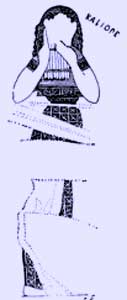
The Muse Calliope with a Syrinx

Pan and Daphnis, Altemps Inv8571
Syrinx (σύριγξ ) (Panpipe (αυλός του Πανός) with usually 7 pipes). Already known in the Cyclades around 2500 BC. According to Mythology Pan fell in love with the waternymph Syrinx. She ran away from him and when she could not cross the river Ladon to escape she asked Artemis to help her. Just as Pan was about to embrace her, Syrinx changed into cattail reeds. Pan holding the marsh reeds sighed in disappointment, causing the wind to blow through the reeds. He was enchanted by the sound, believing it to be the mournful cry of his beloved Syrinx; He produced a set of pipes so that he could have her with him always.
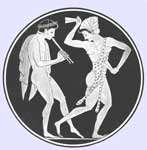
Diaulos Player and Dancing woman, Epiktetos
Diaulos (δίαυλος) “Pipe” (two flutes but probably a oboe like instrument. Phorbeia: A type of bandage that held the two flutes in place using two holes in it in which the flutes could be attached.) According to Aristotle (Politics) pipes should not be used in education because pipe music is orgiastic and it hinders the use of one's logos Eric Csapo (Music and the Muses)
Other Instruments
Kymbala (κύμβαλα )(Cymbals, Cheirokymbala, Anakara) (other names also used Baboulion and Bakyllion, Kymbalion (small version)). A musical instrument, in the shape of two half globes, which were held one in each hand by the performer, and played by being struck against each other. The word is being derived from kumbos hollow (Roman version)
Krembala a kind of Cymbals mentioned in a Homeric poem to Apollo.
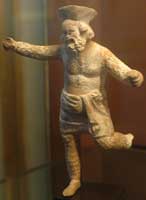
Papposilenus playing the krotala
Krotala (or Crotala) (κρόταλα )(A dancer's instrument like the todays castanets(rattles). From Suidas and the Scholiast on Aristophanes (Nubes,260), probably a split reed or cane, which clattered when shaken with the hand. According to Eustathius it was made of shell and brass, as well as wood. Clemens Alexandrinus says that it was an invention of the Sicilians. The word krotalon is used also as a metaphor, for a noisy talkative person. The sound of the krotala is called rhymbos or rombos. Images Dancer with Krotala
Lutes, tamboura (3 strings) (other versions: skindapsos or kindapsos (4 strings, played with a feather plectrum), pandoura (or trichordo, 3 strings), probably introduced from the east after Alexander the Great expedition)

From an Attic stamnos, Naples Museo Archeologico Nazionale
Tympanon (τύμπανο ) A small drum carried in the hand such as shown often in pictures of Maenads in the train of Dionysus (invented by Cybele), Image: Actor with a tympanon
Kroupezion (κρουπέζιον ) probably a kind of Clatter (foot) instrument used by flute players, a metallic piece attached to the sole of the player (podopsophos)
Xylophon, from xylon, wood, and phone voice, (the original name is unknown, but images exists)
Platagh, Platagwgion an invention of Archytas, a child's rattle

A sanctuary of Athena Trumpet they say was founded by Hegeleos. This Hegeleos, according to the story, was the son of Tyrsenus, and Tyrsenus was the son of Heracles and the Lydian woman; Tyrsenus invented the trumpet, and Hegeleos, the son of Tyrsenus, taught the Dorians with Temenus how to play the instrument, and for this reason gave Athena the surname Trumpet. Pausanias, Description of Hellas
Salpinx, Trumpet, Tyrrhenian (western Italy coast) invention , Notatio salpinx? 490 BC (MP3) (Notatio Musicalis), "a warlike and terrifying instrument", Aristides Quintilianus, Image: Salpinx and Hydraulis Player
...experience enabled men to judge what was or was not really conducive to virtue, and they rejected both the flute and several other old-fashioned instruments, such as the Lydian harp, the many-stringed lyre, the 'heptagon,' 'triangle,' 'sambuca,' the like- which are intended only to give pleasure to the hearer, and require extraordinary skill of hand. Aristotle, Politics

Sambyke
Sambyke (sambuca), Invented by Ibykos from Sikyon

Pandoura
Pandoura
Keras, curved horn instrument
Kochlos, Shell type instrument sounds like a trumpet (Conch Shell, usually the shell called triton or strombus gigas or cassis.

Seistron (See Roman version)

Seistron, Prepalatial period , Heraklion Archaeological Museum
Seistron (σείστρον)(metallic rattle). The most simple version consist of little metal bars tied up to two wooden arms. Probably from Egypt were it was used for religious ceremonies for the goddess Isis. It was held in the right hand and shaken, from which circumstance it derived its name.
Rhombos
Bronteion (Instrument used in theaters to produce thunder noise)
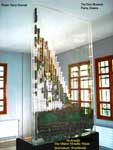
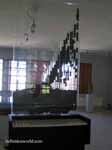
The Hydraulis of Dion,, Dion Archaeological Museum
Hydraulis, Hydraulos or Hydraulikon organon. The first keyboard musical instrument in the history and ancestor of the later church organ, invented by Ctesibius (Ktesibios) in Alexandria. http://www.archaeologychannel.org/content/video/hydraulis_56kW.html (A video of the Hydraulis)
Of course this list is far from complete.
Some instruments not classified yet
Pektis (πήκτις), a pear-shaped lute-type instrument a harp (assumed to be a general name for harps)
Iambyke, harp or lute instrument accompanying the iamboi songs

Plagiaulos (πλαγίαυλος) a side blown flute but probably not commonly used, probably imported from Egypt (or Lybia), another similar instrument was the photinx
Klepsiambos, a nine string instrumens
Psythira (rattles)
Askaulos or Askaules? (from askos and aulos, a bag pipe version) (called aesculus by the Romans according to Dio Chrysostom Nero played such an instrument)
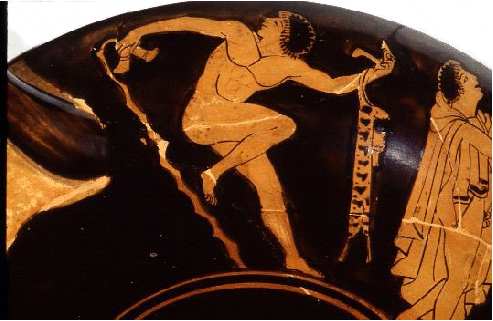
Dancer with krotala (crotala), flute case, and walking stick, Attic red figure kylix, ca. 480 B.C
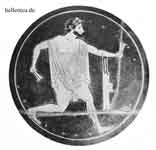
Aeolian Harps, named after the Greek God of Wind, 'Aeolus', first appeared in Grecian culture circa 6 BC, when Orpheus, the 'original' poet, held poetry readings accompanied by the music of Wind Harps. Much later, artisans of the Renaissance era re-discovered Aeolian Harps, fascinated with both their physical and etheric properties. Much experimentation with the Aeolian principle, i.e., the vibration of strings by wind, led to a variety of designs and installations as illustrated by these two towers.(circa 1695 AD) http://www.harmonicwindharps.com/ , The Aeolian Harp . Were such instruments build by the ancient Greeks and if not was the instrument and its name (based on Greek mythology) just invented only in the 17th century?
From the Lyre derived Lyric poetry (a term not used before the Hellenistic times) refers to a song accompanied usually by the lyre (and/or the aulos). Forms of Lyric songs sometimes in combination with dance depending on the occasion are:
Dithyramb, choral song (hymns in honor of Dionysus) at the Dionysia festival, improvised early with the chorus dressed like animals (goats) from which the tragedy (Greek word for song of goats) developed (Herodotus)
Enkomion, praise for some person
Epinikion, song for victory athletic or military “A poet, along with his trained band of singers and musicians, would stand by the altar to the victor’s god and offer “prayer, praise, and admonition mingling with the fumes of intoxicating poetry” (Performance of Epinician Odes)
Erotikon, love songs
Hymenaios, wedding songs “Marriage festivals, for example, used a special kind of lyric poetry called the hymeneal, which was sung during the wedding ceremony. After the wedding, the groom took the bride to his house, accompanied by dancers, instrumentalists, and the singing of another hymenaeum “ (Example from the Iliad ) (Epithalamion)
Hymn, praise for a god
Hyporcheme, song and dance during sacrifice around an altar
Paean, praise song , traditional hymns to Apollo or Artemis such as described by Homer “These prayers varied in length and were sung both on private occasions, such as dinners or weddings, and on public ones, such as festivals or battles”
Partheneion, songs by chorus of maidens
Phallic songs (phallika)
Prosodion, liturgic, thanksgiving “these were sung at festivals by groups of men and woman carrying flowers, sacred emblems, and sacrifices to the gods. Often, the processions were formal and showy and might have been accompanied by other dancers and chorus singers. The prosodia was a recognized form of religious poetry for which many poets composed and even received rewards at festivals”
Skolion, banquet song “along with the accompaniment of a hired lyre player or piper, the guests took turns singing something—a hymn, a commentary, a piece of advice, anything they wished—or continuing what had been sung by the previous singer”
Threnos funeral song
Monodic Lyric (performed by a single person)
Choral Lyric (performed for the public, (festivals, religious or athletic) by a choir)
Comments by Autumn Gurgel Running head: Roots and Theories of the Doctrine of Ethos
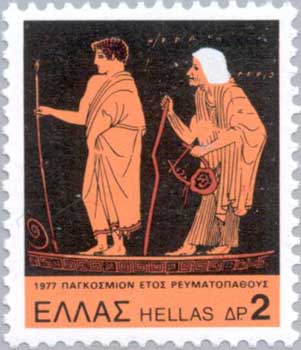
Heracles (Hercules) going to his lessons. He is chaperoned by Linus (some sources say his nanny), who is holding his lyre for him . Heracles teacher of Music was Linus and Eumolpus. Linus tried to punish Heracles who was not a good student but th result was that he was killed by Heracles who could not control his power.
The musical education of the Greeks is stressed by all writers. It must be remembered, however, that the word "music" had a much wider application at that time than it now has. The Greek word mousike at first referred to the arts of the nine Muses. Gradually its meaning was extended to include everything connected with the training of the mind, just as the word gymnastike included everything pertaining to the training of the body. To speak of a Greek as having a good "musical education" is equivalent to saying that he was trained in all the liberal arts, including mathematics. The Greek ideal of education was based upon the idea of universality, of the integration of all branches of learning. "Musical training," Plato said, "is a more potent instrument than any other, because rhythm and harmony find their way into the inward places of the soul, on which they mightily fasten." To this he added gymnastics, insisting, however, that even physical exercise should be performed for the benefit of the soul, since the soul demands a temple worthy of its occupancy. The combination of music and gymnastics, he said, produces a harmonious balance between soul and body. Physical training develops courage and fortitude; music develops a love of the beautiful, and affords the mental and moral discipline necessary to the acquirement of philosophical knowledge. He considered music, however, as the more important of the two, describing it as the fortress of the State. He warned all intelligent rulers to pay careful attention to the development of music in their state, never allowing bad qualities to creep into it, as these would affect the mental and moral stamina of the citizens who listened to it. Finally he insisted that all art be subordinated to ethics and used as a means of moral education.
Part 2: Musicians, Theory, Images
Ancient Greek music, Martin Litchfield West
Ancient Greek music: a new technical history, Stefan Hagel
Apollo's lyre: Greek music and music theory in antiquity and the Middle Ages, Thomas J. Mathiesen
Woman's songs in Ancient Greece, Anne Lingard Klinck
| Ancient Greece
Science, Technology , Medicine , Warfare, , Biographies , Life , Cities/Places/Maps , Arts , Literature , Philosophy ,Olympics, Mythology , History , Images Medieval Greece / Byzantine Empire Science, Technology, Arts, , Warfare , Literature, Biographies, Icons, History Modern Greece Cities, Islands, Regions, Fauna/Flora ,Biographies , History , Warfare, Science/Technology, Literature, Music , Arts , Film/Actors , Sport , Fashion --- |

